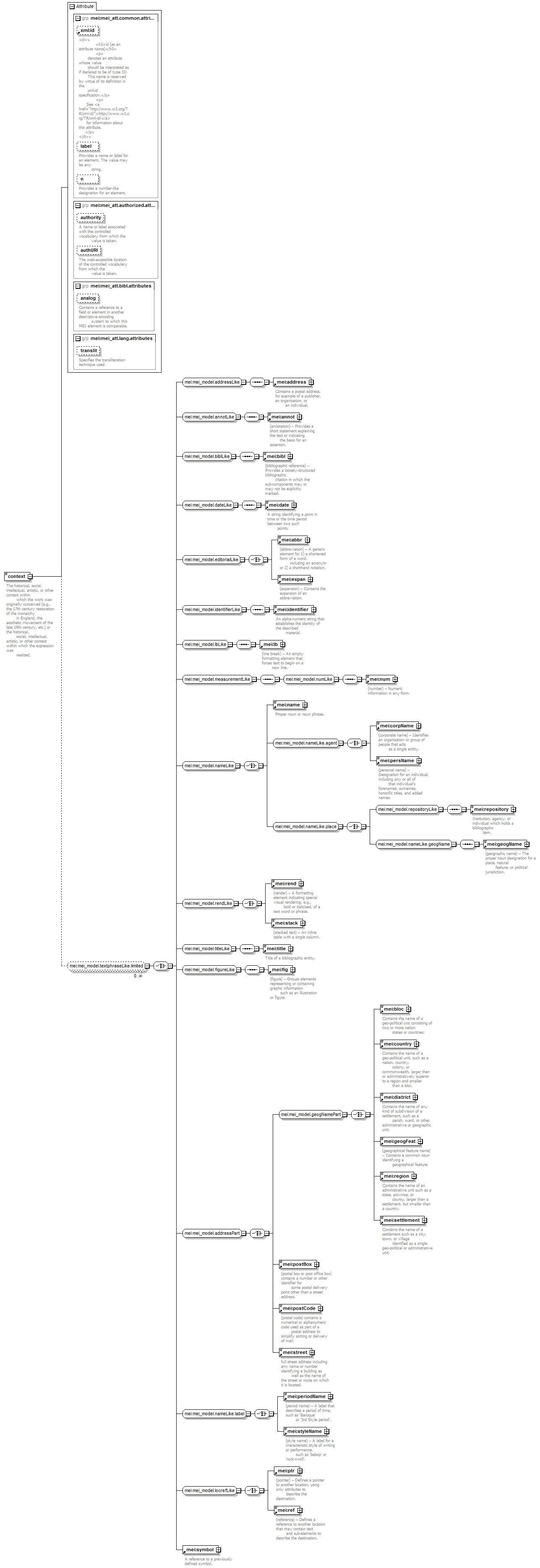mei:context
The historical, social, intellectual, artistic, or other context within which the work was originally conceived (e.g., the 17th century restoration of the monarchy in England, the aesthetic movement of the late 19th century, etc.) or the historical, social, intellectual, artistic, or other context within which the expression was realized. |
Element Information
Model
(mei:address) | (mei:annot) | (mei:bibl) | (mei:date) | mei:abbr | mei:expan | (mei:identifier) | (mei:lb) | (mei:num) | mei:name | mei:corpName | mei:persName | (mei:repository) | (mei:geogName) | mei:rend | mei:stack | (mei:title) | (mei:fig) | mei:bloc | mei:country | mei:district | mei:geogFeat | mei:region | mei:settlement | mei:postBox | mei:postCode | mei:street | mei:periodName | mei:styleName | mei:ptr | mei:ref | mei:symbol
Children: mei:abbr, mei:address, mei:annot, mei:bibl, mei:bloc, mei:corpName, mei:country, mei:date, mei:district, mei:expan, mei:fig, mei:geogFeat, mei:geogName, mei:identifier, mei:lb, mei:name, mei:num, mei:periodName, mei:persName, mei:postBox, mei:postCode, mei:ptr, mei:ref, mei:region, mei:rend, mei:repository, mei:settlement, mei:stack, mei:street, mei:styleName, mei:symbol, mei:title

Attributes
| QName | Type | Fixed | Default | Use | Inheritable | Annotation | |
|---|---|---|---|---|---|---|---|
| analog | xs:string | optional |
|
||||
| authURI | mei:mei_data.URI | optional |
|
||||
| authority | xs:string | optional |
|
||||
| label | xs:string | optional |
|
||||
| n | optional |
|
|||||
| translit | xs:NMTOKEN | optional |
|
||||
| xml:base | mei:mei_data.URI | optional |
|
||||
| xml:id | xs:ID | optional |
|
||||
| xml:lang | xs:language | optional |
|
Used By
Source
<xs:element name="context"> <xs:annotation> <xs:documentation>The historical, social, intellectual, artistic, or other context within which the work was originally conceived (e.g., the 17th century restoration of the monarchy in England, the aesthetic movement of the late 19th century, etc.) or the historical, social, intellectual, artistic, or other context within which the expression was realized.</xs:documentation> </xs:annotation> <xs:complexType mixed="true"> <xs:group minOccurs="0" maxOccurs="unbounded" ref="mei:mei_model.textphraseLike.limited"/> <xs:attributeGroup ref="mei:mei_att.common.attributes"/> <xs:attributeGroup ref="mei:mei_att.authorized.attributes"/> <xs:attributeGroup ref="mei:mei_att.bibl.attributes"/> <xs:attributeGroup ref="mei:mei_att.lang.attributes"/> </xs:complexType> </xs:element> |